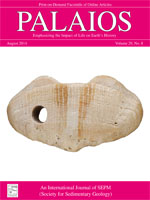Drillholes represent direct evidence of ecological interactions in the fossil record. Most of them have been interpreted as predatory in origin and enable the analysis of behavioral information of both predator and prey. Drillholes have been found in a variety of fossil organisms, but this is the first report of a bored fossil chiton plate. It was found in the La Coronilla deposit, a Late Pleistocene invertebrate assemblage from southeastern Uruguay. The drillhole belongs to the ichnospecies Oichnus simplex and is attributed to a muricid gastropod, which could likely have been the ocenebrinid Urosalpinx haneti, recorded in the fossil assemblage. The drillhole features all traits for a predatory origin. However, the rareness of this particular interaction between chitons and gastropods in the fossil record and in the recent, could signify an event of arbitrary drilling. The reported occurrence here raises the question as to whether this behavior represents an understudied ecological interaction between polyplacophorans and gastropods.
How to translate text using browser tools
1 November 2014
THE FIRST PREDATORY DRILLHOLE ON A FOSSIL CHITON PLATE: AN OCCASIONAL PREY ITEM OR AN ERRONEOUS ATTACK?
ALEJANDRA ROJAS,
MARIANO VERDE,
DIEGO URTEAGA,
FABRIZIO SCARABINO,
SERGIO MARTÍNEZ
ACCESS THE FULL ARTICLE
It is not available for individual sale.
This article is only available to subscribers.
It is not available for individual sale.
It is not available for individual sale.

PALAIOS
Vol. 29 • No. 8
August 2014
Vol. 29 • No. 8
August 2014




